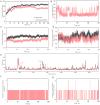Potential candidates from a functional food Zanthoxyli Pericarpium (Sichuan pepper) for the management of hyperuricemia: high-through virtual screening, network pharmacology and dynamics simulations
- PMID: 39722812
- PMCID: PMC11668583
- DOI: 10.3389/fendo.2024.1436360
Potential candidates from a functional food Zanthoxyli Pericarpium (Sichuan pepper) for the management of hyperuricemia: high-through virtual screening, network pharmacology and dynamics simulations
Abstract
Introduction: Hyperuricemia (HUA) is a metabolic syndrome caused by purine metabolism disorders. Zanthoxyli Pericarpium (ZP) is a medicinal and food homologous plant, and its ripe peel is used to treat diseases and as a spice for cooking. Some studies have shown that ZP can inhibit the formation of xanthine oxidase and reduce the production of uric acid.
Methods: Through network pharmacology, ZP's potential targets and mechanisms for HUA treatment were identified. Databases like TCMSP, UniProt, and Swiss Target Prediction were utilized for ZP's active ingredients and targets. HUA-related targets were filtered using GeneCards, Drugbank, and Open Targets. Core targets for ZP's HUA treatment were mapped in a PPI network and analyzed with Cytoscape. GO and KEGG pathway enrichments were conducted on intersected targets via DAVID. Molecular docking and virtual screening were performed to find optimal binding pockets, and ADMET screening assessed compound safety. Molecular dynamics simulations confirmed compound stability in binding sites.
Results: We identified 81 ZP active ingredient targets, 140 HUA-related targets, and 6 drug targets, with xanthine dehydrogenase (XDH) as the top core target. Molecular docking revealed ZP's active ingredients had strong binding to XDH. Virtual screening via Protein plus identified 48 compounds near the optimal binding pocket, with 2'-methylacetophenone, ledol, beta-sitosterol, and ethyl geranate as the most promising. Molecular dynamics simulations confirmed binding stability, suggesting ZP's potential in HUA prevention and the need for further experimental validation.
Conclusion: Our study provides foundations for exploring the mechanism of the lowering of uric acid by ZP and developing new products of ZP. The role of ZP in the diet may provide a new dietary strategy for the prevention of HUA, and more experimental studies are needed to confirm our results in the future.
Keywords: Zanthoxylum bungeanum; complementary and alternative medicine; hyperuricemia; medicine and food homologous plant; molecular docking; molecular dynamics simulation.
Copyright © 2024 Chen, Chen, Chen, Chu, Yang, Wu, You, Hung, Yang, Sun, Zhou, Zhao, Li and Liu.
Conflict of interest statement
The authors declare that the research was conducted in the absence of any commercial or financial relationships that could be construed as a potential conflict of interest.
Figures








Similar articles
-
Identification of inhibitors from a functional food-based plant Perillae Folium against hyperuricemia via metabolomics profiling, network pharmacology and all-atom molecular dynamics simulations.Front Endocrinol (Lausanne). 2024 Feb 16;15:1320092. doi: 10.3389/fendo.2024.1320092. eCollection 2024. Front Endocrinol (Lausanne). 2024. PMID: 38435751 Free PMC article.
-
A Network Pharmacology Method Combined with Molecular Docking Verification to Explore the Therapeutic Mechanisms Underlying Simiao Pill Herbal Medicine against Hyperuricemia.Biomed Res Int. 2023 Feb 9;2023:2507683. doi: 10.1155/2023/2507683. eCollection 2023. Biomed Res Int. 2023. Retraction in: Biomed Res Int. 2024 Jan 9;2024:9754274. doi: 10.1155/2024/9754274. PMID: 36817858 Free PMC article. Retracted.
-
The Potential Mechanism of Alpiniae oxyphyllae Fructus Against Hyperuricemia: An Integration of Network Pharmacology, Molecular Docking, Molecular Dynamics Simulation, and In Vitro Experiments.Nutrients. 2024 Dec 28;17(1):71. doi: 10.3390/nu17010071. Nutrients. 2024. PMID: 39796505 Free PMC article.
-
Integrative metabolomics and network pharmacology to study the preventative impact of dioscin treatment on hyperuricemia.Biomed Chromatogr. 2023 Mar;37(3):e5558. doi: 10.1002/bmc.5558. Epub 2023 Jan 3. Biomed Chromatogr. 2023. PMID: 36468521 Review.
-
Natural polysaccharides in the prevention of hyperuricemia: Source, classification, mechanism, application in food industry.Int J Biol Macromol. 2025 Jan;286:138421. doi: 10.1016/j.ijbiomac.2024.138421. Epub 2024 Dec 5. Int J Biol Macromol. 2025. PMID: 39645137 Review.
References
-
- Khanna D, Fitzgerald JD, Khanna PP, Bae S, Singh MK, Neogi T, et al. . American college of rheumatology guidelines for management of gout. Part 1: Systematic nonpharmacologic and pharmacologic therapeutic approaches to hyperuricemia. Arthritis Care Res. (2012) 64:1431–46. doi: 10.1002/acr.21772 - DOI - PMC - PubMed
MeSH terms
LinkOut - more resources
Full Text Sources
Miscellaneous

